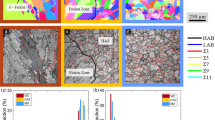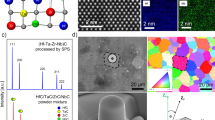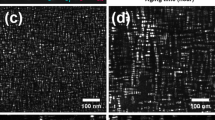Abstract
GRAIN boundary cementite films are known to have an important influence on the cleavage fracture of low carbon steels1–6. Plastic deformation in the ferrite matrix results in the formation of cracks within the cementite which can lead to grain-size microcracks1,5 or complete failure of a tensile specimen. The cracks in the carbides are widely believed to be nucleated by slip or twinning dislocation pile-ups and Smith7,8 has described this process by a model developed from those of Cottrell9 and Petch10. This model is consistent with many experimental observations, in particular with the influence of microstructure and superimposed hydrostatic stress on fracture behaviour2,11. There are, however, certain inconsistencies between the experimental observations and fracture theories based solely on the micro-mechanistic approach. These include the observed limited propagation of cementite cracks into ferrite1,5 and the increased tendency for carbides to crack as the film thickness is reduced. Furthermore, carbide orientation influences the tendency to crack (Fig. 1) and there is a higher probability for carbides to fracture at the mid-length position (Fig. 2). It is proposed that these observations can be explained if, once plastic yielding has occurred in the matrix, fibre loading can lead to stresses in carbide films sufficient to cause fracture.
This is a preview of subscription content, access via your institution
Access options
Subscribe to this journal
Receive 51 print issues and online access
$199.00 per year
only $3.90 per issue
Buy this article
- Purchase on Springer Link
- Instant access to full article PDF
Prices may be subject to local taxes which are calculated during checkout
Similar content being viewed by others
References
McMahon, C. J., and Cohen, M., Acta Met., 13, 591 (1965).
Oates, G., J. Iron Steel Ind., 206, 930 (1968).
Bruckner, W. H., Welding J., 29, 467 (1950).
Allen, N. P., Rees, W. P., Hopkins, R. E., and Tipler, H. R., J. Iron Steel Ind., 174, 108 (1953).
Lindley, T. C., J. Iron Steel Ind., 207, 984 (1969).
Lindley, T. C., and Richards, C. E., Metal Sci. J. (in the press).
Smith, E., Physical Basis of Yield and Fracture (Institute of Physics and Physical Society, 1966).
Smith, E., Int. J. Fracture Mechanics, 4, 131 (1968).
Cottrell, A. H., Trans. Amer. Inst. Mech. Eng., 212, 192 (1958).
Petch, N. J., Fracture, Swamscott Conference (Wiley, 1959).
Oates, G., J. Iron Steel Ind., 207, 353 (1969).
Kelly, A., and Davies, G. J., Met. Rev., 10, 21 (1965).
Webb, W. W., and Forgeng, W. D., Acta Met., 6, 462 (1958).
Author information
Authors and Affiliations
Rights and permissions
About this article
Cite this article
LINDLEY, T., OATES, G. & RICHARDS, C. Fibre-loading Mechanism for the Fracture of Cementite Films in Ferrite. Nature 226, 145–146 (1970). https://doi.org/10.1038/226145a0
Received:
Issue Date:
DOI: https://doi.org/10.1038/226145a0
Comments
By submitting a comment you agree to abide by our Terms and Community Guidelines. If you find something abusive or that does not comply with our terms or guidelines please flag it as inappropriate.



